A.J.S. Rayl • Sep 30, 2009
Mars Exploration Rovers Update: Embedded Spirit Waits Exit Approval, Opportunity Celebrates New Mars Year with New Record
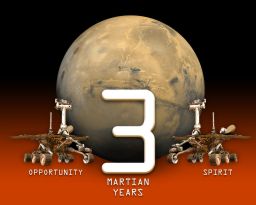
Three Mars years
Sol 2008 -- August 26, 2009 for Spirit and September 16, 2009 for Opportunity -- marks three Martian years of explortation for the twin robot field geologists. A year on Mars is approximately 687 Earth days, making a Mars year almost twice as long as a year on Earth. The rovers will celebrate six Earth years on Mars in January 2010. Credit: Astro0 / rover art by Dan Maas / Mars by NASA / JPL-Caltech / Malin Space Science Systems
From notable achievements and new discoveries to trials and tribulations and harbingers of hope, the Mars Exploration Rovers seemed to experience the gamut on the Red Planet this September, their 69th month on an expedition that originally set out back in 2004 for a three-month tour.
While Opportunity seemed to effortlessly sail through the month, celebrating its third Mars year, checking out the largest meteorite found on the mission so far, and setting a new rove record, Spirit, still embedded in what turns out to be the edge of sand-filled crater west of Home Plate, suffered a communications setback and was forced to temporarily scale back operations just as the team settled on an exit strategy.
As the month began, Opportunity was wrapping up its six-week meteoric study at Meridiani Planum by driving around the watermelon-sized, iron-nickel rock dubbed Block Island and taking pictures for a 3-D model of the heavyweight Martian invader. Then, the rover hit the road, continuing its long journey to Endeavour Crater. It's following the latest route charted a couple of months back to avoid a potentially troublesome field of large sand ripples or purgatoids, as they are not so-affectionately known. Pictures from the HiRISE camera onboard the Mars Reconnaissance Orbiter (MRO) give the MER team the luxury of seeing what lies ahead and they have come to rely now on those pictures from on high to guide the rovers' explorations.
It will forever be a September to remember for Opportunity since it completed its third Mars year on the 16th and caught up with Spirit in the record books. It then raced into its new year establishing a new all-time rove record during a 59-meter (194-foot) run on September 23 that pushed its odometer to 17,717.33 meters or 11.01 miles. It would be easy to gloss over that achievement, but the rovers were only "warrantied" to put 500 meters (.3 mile) on their rocker bogies or 1 kilometer (.6 mile) between them. So, 11 miles is a huge accomplishment worthy of special note. It’s still got miles to go before it sleeps, to adapt the words of poet Robert Frost, at least 14 more miles before it can pull up and rest at Endeavour. Daunting as that may be, Opportunity is roving up to the plate and this month brought newfound reason to believe it can meet the challenge.
Drive after drive this month, Opportunity rolled along in its old carefree way, which is especially good news since it had been having trouble with its right front wheel for months. After leaving Victoria Crater almost one year ago, the rover was regularly making 80-100+-meter drives and earlier this year those long runs began causing that wheel to "heat up." More specifically, the wheel was drawing more current to its actuator or motor than the other five wheels, in some instances as much as twice as much. During the last couple of weeks, however, the rover has been taking 70-meter (230-foot) jaunts every other sol or so, logging more than 500 meters (.3 mile) in a relatively short period of time with no problems. “We're in a region where the driving is pretty easy,” said Steve Squyres, MER principal investigator, of Cornell University. "Looking out the front windshield, it's nothing but ripples right now. The scenery isn't changing much, so we’re really just putting miles behind us.”
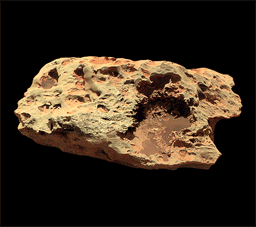 Block Island
Block IslandOpportunity captured these six views of the watermelon-sized meteorite dubbed Block Island this month, as it circumnavigated the hunk of iron-nickel rock that invaded Mars a long, long time ago. This is the largest meteorite found to date on the mission and it is estimated to weigh in at around one ton. Its size alone indicates that it hit the surafce at a time when Mars' atmosphere was much denser. A Quicktime version of the animation is available here (26 MB).Credit: NASA / JPL-Caltech / Cornell / color composites and animation by Astro0
Since Opportunity’s right front wheel is stuck and toed in a bit, probably because of a broken motor winding in the steering actuator, the MER engineers expect that it will always draw a little more current than the other five wheels. "It's pushing this wheel at an odd angle, so it's got to work a little harder compared to the other wheels," explained Bill Nelson, chief of the rover engineering team at JPL, where the twin robot field geologists were designed and built, and are being managed.
Although they don't know exactly what is causing the extreme rise in the right front wheel current, the engineers suspect it’s probably migration of the lubricant out of the gearbox. “The one known solution for that is to not use the wheel,” said Nelson, “so we've had drive stand downs this year, where we do a science campaign for two, three weeks to give it a rest and usually, the drives after these stand downs look pretty good.”
The MER engineers have also been implementing other techniques to alleviate the wheel’s high current draw during Opportunity's long treks. Since departing Block Island this month, for example, the rover has been driving backwards "exclusively," limiting the drives to 70 meters, and heating the wheels not only before the drives but on non-drive sols as well; consequently, the right front wheel has been, “very well behaved,” Nelson reported. “We believe this combination of techniques is what has helped keep those wheel currents under control and the driving has been remarkably good,” he said. Indeed, Opportunity seemed to cruise to the end of the month almost as gracefully as it did in the early days back in 2004 when it first ventured out of Eagle Crater and onto the Meridiani plains, only backwards and with its arm positioned out front, in the fisher position, because of a broken shoulder joint.
Although Opportunity is still heading westward to avoid the field of purgatoids, it will soon be driving back to the east and then to the south, roving along a straighter path toward Endeavour. “These purgatoids are not quite as high as Purgatory Dune, for which they were named, but they are keeping the rover planners on their toes, because they don't ever want to get stuck in a dune like that again, especially having Spirit stuck at the same time,” Nelson noted.
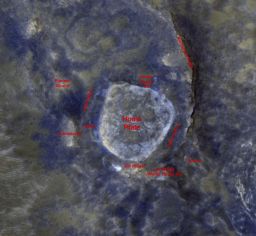 Spirit at Home Plate
Spirit at Home PlateThe HiRISE camera on the Mars Reconnaissance Orbiter took another look at Spirit's current location just to the west of the circular plateau named Home Plate, on July 16, 2009.Home Plate is about 80 meters (about 260 feet) across. Spirit is the bright dot just to the left of the geologic formation, at the 9 o'clock position. North is toward the top. Credit: NASA / JPL / UA / annotations by Emily Lakdawalla
Despite Opportunity’s achievements this month, Spirit still drew the spotlight to the other side of the planet, even as dust fallout from the regional storms last month led to a dramatic drop in power production and signaled what would become another tough month for this rover to endure. After spending the first two weeks of September successfully continuing its in-depth examinations of selected soil and bedrock targets within its reach at the top of the month, a fault occurred in Spirit's high gain antenna (HGA), putting the MER engineers on the track of troubleshooting. Since the team uses the HGA to uplink the rover's daily assignments, this fault all but brought Spirit's agenda to a stop, reported Ray Arvidson, MER deputy principal investigator, of Washington University St. Louis.
The initial post-glitch diagnostics -- which involved moving the antenna five degrees in one direction and back – seemed to indicate that the motors were operating as designed and that the issue is most likely an intermittent electrical issue with the dynamic brake in one of the actuators or motors. The silver lining in the darkened skies over Gusev Crater is that the MER team and Spirit have experienced similar actuator problems before, including on the rover’s right front and left rear wheels. “It turns out that gunk can build up on the relays and there are tricks you can try to clean it off," Squyres said. "Either those tricks work or they don't, but, in any case, we can work around it.”
The hope was that the glitch would be intermittent enough that they wouldn’t have to worry about working around it, but when the rover planners commanded Spirit through the HGA this last weekend, it failed again, Arvidson said, four minutes before the end of the 20-minute communication window.
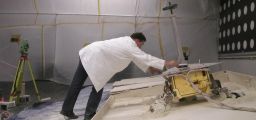 Testing with the SSTB Lite
Testing with the SSTB LiteMER team member Walter Hoffman was captured in this picture taken on Sep. 8, 2009, checking for a change in the tilt of the Surface System Test Bed (SSTB) Lite rover after an arc-backwards maneuver. This test rover weighs about the same on Earth as Spirit does on Mars. Unlike the SSTB, the primary test rover in use at JPL, the lighter model does not carry science instruments or a robotic arm. Computer modeling using results from both test rovers and data from Mars helped the rover team plot a strategy to try getting Spirit out of a patch of soft Martian soil where Spirit has been embedded for more than five months.Credit: NASA / JPL-Caltech /
“Spirit did get our commands though and we know now that this dynamic brake is an intermittent problem," Nelson added. Still, it was clear the issue is going to occur frequently enough to interfere with operations. "So, the endpoint on this probably is to mask it off in the flight software. That means we simply don't check to see if the dynamic brake is on or off. We'll still command it, so if it's working, the brake will still be applied and released.” The MER engineers are currently analyzing the situation with tentative plans to mask the relay sometime in the next two weeks, he said. “It’s just a matter of time before we return the HGA to service.”
Although Spirit was pulled off its planned schedule as the team engineers worked the HGA issue, it hasn't just been sitting there doing nothing. True to its MER nature, the rover has carried on, performing “run-outs,” the small, easy pre-programmed tasks uploaded long ago just in case of unexpected situations like this. “We have been basically monitoring the dust in the atmosphere and conducting searches for dust devils, and we have also managed to do a few soil measurements," said Arvidson.
With Spirit still mobility impaired and this latest, antenna glitch slowing things on Mars, most of the action in September took place on Earth, where, actually, it has been for the last couple of months. It turns out that the rover's left wheels are sunk into not just a little sandy pit, but the western side of what is now being called Scamander Crater, a sand-filled hole, which, according to Arvidson, is “about 8 meters (26.2 feet) wide, maybe 30 centimeters (11.8 inches) deep." That, he added, is what is causing the rover's "12- degree roll to the west."
Since the beginning of July, MER engineers and scientists have been putting test rovers on the ground through all kinds of moves in the In Situ Instrument Laboratory (ISIL) at JPL. After directing the main Surface System Test Bed (SSTB) rover – an exact replicate of Spirit and Opportunity – through all the potential exit maneuvers, they focused this month on putting the SSTB Lite rover the same paces. Unlike the SSTB, the SSTB Lite doesn't carry science instruments or sport a robotic arm, but it weighs about the same on Earth as Spirit does on Mars, thus more accurately reproduces the ground pressure of the wheels. Consider that an object that weighs 10 pounds on Earth weighs just 3.8 pounds on Mars, and it’ easy to see that the difference is significant. Moreover, the SSTB Lite "behaves differently," said Arvidson. "It’s been an important addition to the testing.”
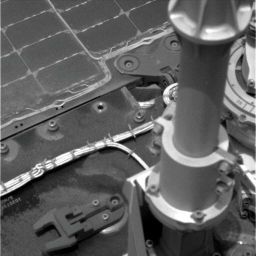 The dust cometh back
The dust cometh backSpirit used its panoramic camera (Pancam) on its Sol 2017 (Sep. 5, 2009) to take this raw image of part of its deck and solar array. Dust from last month's regional storms has settled on the rover and is easily visible in the left-hand corner of the frame.Credit: NASA / JPL-Caltech / Cornell University
“The SSTB Lite is important because it's a more physically accurate test of what happens on Mars; whereas, the SSTB, because it is so flight-like, provides an opportunity to do a dress rehearsal,” Squyres elaborated. "You couldn't do a dress rehearsal with the SSTB Lite, because it doesn't have the instrumentation that you need to collect the data, so both vehicles are crucial to this extraction.”
Even with both of the ground rovers however the team can never duplicate what happened to Spirit on Mars. "We aren't working with the exact same soils and there are still a lot of unknowns about Spirit's situation," Arvidson noted. “The main point of the testing is to gain insight into the commands and the rover responses."
“The situation on Mars is too complex for us to duplicate it precisely down on Earth,” Squyres added. “All we can see is what's on the surface and what matters is what's below the surface where we can't see it. So, there's no way we can with complete accuracy replicate the situation we're in on Mars. That's a fool's errand. There's no way to do it." Nelson agreed: “Mars will teach us a bunch of new lessons as we attempt extrication and we will respond to them.”
Difficulties acknowledged, the team has worked doggedly to gain all the insight it can get. In addition to the team’s working with the SSTBs, Arvidson and mechanical engineer Randy Lindemann, of JPL, have also been feeding all the acquired data into a computer model of Spirit's predicament.
September has been, in a word, “frustrating” for the Spirit team, as Arvidson put it. “We're all pretty concerned, but we still have a vehicle that works,” he underscored. And, after a lot of hard work throughout the last three months by a mission team as devoted as they get, the best news of the month emerged just this week.
 Ready for the Set and Go
Ready for the Set and GoThe little rover that could did and got its own page for the public to follow its extrication from the sand-filledcrater into which its left wheels accidentally slipped last May. The rover now has its own exit site: www.jpl.nasa.gov/freespirit/
Credit: NASA / JPL-Caltech / John Howard
“We have an exit plan,” Arvidson announced. “We have basically beaten this to death in the test bed and after all the testing we did for weeks on end, we have finally settled on the plan for extracting Spirit from Troy,” added Squyres.
If everything goes as expected, Spirit will be commanded through a series of forward moves combined with crabbing uphill, an exit strategy the team had pretty much settled on before bringing the SSTB Lite into the ISIL this month for testing. Although the team has been leaning toward this plan for a while, as covered in last month’s MER Update, the decision has now been made for the record. "The focus at this point is on validating the extraction plan that we have converged on,” said Squyres.
That validation requires that the team conduct an operational readiness test (ORT). In essence, that means they will put the SSTB rover through the chosen series of moves, “treating it as if it were on Mars to make sure that we’re ready for the ultimate extraction on Mars,” explained Nelson.
Provided the plan works in the ORT or dress rehearsal in the ISIL, the team will present it to a review board, then to NASA headquarters officials and JPL management for approval. And then, at long last, the rover drivers will begin the process of commanding Spirit to roll onward. "We're at the ready in that ready-set-go mode," described Nelson. "We've got the ORT and the review for the ‘set,’ then we're going to go." Everyone on the team is excited and enthusiastic about getting Spirit back on the road, he said, and optimism remains high.
“We all recognize there is a chance that the rover will not get out,” said Squyres. But, he added: “I have seen the mood of the team lift perceptibly in the last week or two as we have wrapped up the exploratory phase of the testing and converged on the plan – and this team is very good at taking a good plan and executing it. I'm feeling really good about our decision.”
 Remember when: A 300-million-mile hole-in-one
Remember when: A 300-million-mile hole-in-oneOpportunity took this color picture with its panoramic camera on the first day of its expedition of Meridiani Planum. The view is to the west-southwest of the rover. The rim of the crater is approximately 10 meters (32 feet) from the rover. The crater is estimated to be 20 meters (65 feet) in diameter. The scientists were in a state of "shock and awe," as Pancam Lead Jim Bell, President of The Planetary Society, put it when they saw the abundance of rock outcrops dispersed throughout the crater. Data taken from the camera's near-infrared, green and blue filters were combined to create this approximate true color picture.
Credit: NASA / JPL-Caltech / Cornell University
The rover drivers, it may go without saying, are ready to rock and roll Spirit out of Troy and get it back on track to its next study sites, von Braun and Goddard, to the south of Home Plate. "They are anxious to get started on Mars and they're convinced, and I think rightly, that we will ultimately get this machine out of there,” offered Nelson.
Spirit has been parked for five months now -- its odometer at 7,729.93 meters (4.80 miles) -- and it’s probably going to be another month or so before the team can finish the dress rehearsal and get the green light of official approval to begin sending the exit commands up to the rover. Even then, be prepared to wait some more, team members warn, because it’s going take weeks and thousands of revolutions of the wheels just to move a few centimeters.
“Hopefully, we'll start driving – hopefully – in early November,” said Arvidson.
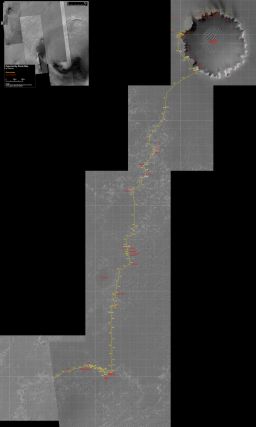 Opportunity Route Map
Opportunity Route MapThis series of images, annotated by Eduardo Tesheiner, shows Opportunity's route through September 2009. The rover is heading toward its biggest attraction yet, Endeavour Crater, still some 14 miles away by the route it's taking.Credit: NASA / JPL-Caltech / UA / MSSS / annotation by Eduardo Tesheiner
In the meantime, as September comes to an end, Spirit and Opportunity are both in overall good health and each has more than enough power to meet the workloads. As usual, especially for this late-summer early-fall time of year on Mars where the rovers are, the amount of power the solar-powered 'bots were able to produce fluctuated as the month progressed, because of the dust in the atmosphere whipped up by several regional storms during July and August.
After dropping from record high levels of 900+ watt-hours in August, Spirit began September averaging around 418 watt-hours. The skies there were still really dusty then, somewhat resembling the recent smoke-filled skies of L.A., created by the summer’s firestorms that briefly threatened the rovers’ home last month. Even so, Spirit was still making use of 66% of the sunlight penetrating its solar arrays. As the weeks passed, the dust in the atmosphere slowly began to clear, and the rover ends September with levels hovering around 420 watt-hours, about where it began the month.
“Spirit's dropped a lot of its power, because we've picked up some dust on the arrays,” said Squyres. “This is just typical of what we've seen each [Mars] year. About this time of the [summer-to-fall] season, we get a big cleaning event and – whoosh – the rover gets cleaned off. Then, all the dust that's kicked up into the atmosphere by the Martian winds has to go some place and a lot of it seems to go on Spirit's solar arrays. For a long time, I let this dust stuff make me crazy, and what I've come to realize is that dust happens. I can sit here with some confidence and say that I think a little less than a year from now we'll probably have another big cleaning event on Spirit. We have to wait for it, but it's happened each and every year we've been there.”
“Spirit does look a little dirtier,” Arvidson agreed. “But it’s still a lot better, a lot cleaner than it was before the big cleaning event during the summer.” For those following this mission, power levels in the 400s for Spirit is actually something to cheer about considering that this rover struggled for more than two years with levels consistently dipping to the low 200s, levels once thought to be terminal.
Opportunity, the luckier of the twins, got a little of the dust on its solar arrays blown away earlier in the month, which pushed its power production from the high 400s in August, to 527 watt-hours in early September. At month's end, however, it is averaging about 480 watt-hours, plenty of power for it to keep its pedal in coming sols.
As September gives way to October, Opportunity will likely keep on keepin' on, while Spirit will continue to command special attention. "The most important thing that happened this past month is that we converged on the exgtraction plan for Spirit," summed up Squyres. "It's going to be a little while before we're ready to execute it because we want to make sure we do all the things that must be done before we move on. But I'm feeling really good about our decision."
"We won’t give up," added Nelson. "As long as we have the power and the wheels to turn this rover, we're going to get Spirit out one way or another."
Support our core enterprises
Your support powers our mission to explore worlds, find life, and defend Earth. You make all the difference when you make a gift. Give today!
Donate

 Explore Worlds
Explore Worlds Find Life
Find Life Defend Earth
Defend Earth

